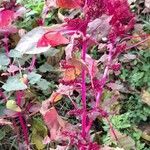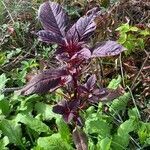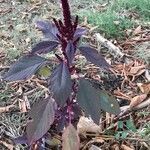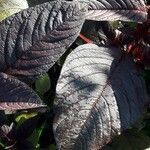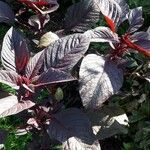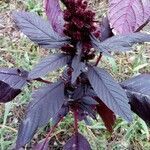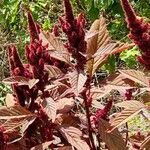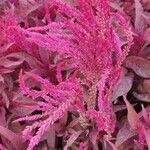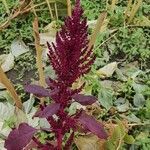Coarse usually pubescent annuals to 2 m. high, simple or with ascending branches. Leaves glabrous above, pubescent or glabrate below, entire to minutely crenulate, ovate to rhombic, apically rounded to acute and mucronate, basally acute to cuneate, 3-15 cm. long, 1-6 cm. broad; petioles 1-8 cm. long. Inflores-cences of thyrses racemosely disposed, the terminal and axillary thyrses cylindric, often drooping, 5-15 mm. broad. Flowers polygamo-monoecious or monoecious; bracts and bracteoles subequal, lanceolate to ovate, 1.5-2.5 mm. long; sepals 5, oblong to ovate, rounded to mucronate apically, 1.5-2 mm. long, the midribs dark green, the margins scariose and tinted with anthocyanins; stamens 5, discrete, 1-2 mm. long; ovary compressed globose, capped by a circular stylopodium; stigmata 3 (-4), longer than the stylopodium. Fruit a smooth to rugulose subglobose utricle, circumscissile near the middle, about 2 mm. long, usually exceeding the sepals; seeds cochleate-orbiculate, dark reddish brown to black, minutely reticulate, 1-1.3 mm. broad.
Annual, often much-branched, erect herb, to c. 1 m high, glabrous or nearly so (apart from infl. rhachis). Petioles of lower lvs to c. 10 cm long. Lamina of middle and upper cauline lvs 3-8 × 1-6 cm, lanceolate, ovate or rhombic, often red-tinged, glabrous at maturity; base cuneate; apex obtuse to acute. Infl. a dense spike-like panicle, interrupted towards the base, ± crimson, usually with a few branches, but simpler in plants on impoverished soils; main spike to c. 25 cm high, drooping towards apex; lateral spikes c. 10 cm or more, also drooping. Rhachis hairy. Longer bracteoles 3-4 mm long, ovate; apex subulate; keel greenish to red; shorter bracteoles similar. Tepals (4)-5, subequal, 1.5-2.3 mm long, scarcely imbricate, slightly larger in ♂ fls, oblong or obovate-oblong; keel darker than rest of tepal; apex obtuse, acute or mucronate. Stigmas 3, > perianth. Fr. ± broadly ellipsoid, = or < perianth, circumscissile, ± rounded at apex. Seed 1-1.3 mm diam., orbicular, shining dark brown.
An annual erect plant. It grows to 2 m high. The stems are angular. It often branches in the upper section. It is smooth but may be hairy on younger plant parts. The young parts can be tinged purple. The leaves are oval to sword shaped and can be 10-15 cm long by 3-6 cm wide. They have a leaf stalk 1-7.5 cm long. The leaves often narrow towards the tip. They can also become thinner towards the base. There may be hairs on the midrib. The leaf may be tinged purple underneath. The flowers clusters are often branched and on side branches. The stiff branched flower arrangement at the top can be 15-25 cm long. The fruit is oval and the seed can be 1-1.3 mm across. The seed is dark brown but pale brown forms are used as grain in Central America.
Cultigen apparently derived from A. hybridus; infl large and showy, mostly bright red in life, lax, at least the terminal thyrse generally nodding or drooping; bract of the pistillate fls with slender midrib, not surpassing the fr; sep 5, straight, unequal, the shorter (inner) ones less than 2 mm, oblong, acutish, ca half as long as the fr; style-branches erect; seeds in ornamental forms dark brown; 2n=32, 34. Originally cult. for grain and dyestuff, now relictual as a grain-plant, but widely cult. as an ornamental and pot-herb, and occasionally escaping or persistent, but scarcely established in our range. (A. hybridus ssp. c.)
Stem erect, green, glabrous. Petiole green; leaf blade rhombic-ovate or oblong-lanceolate, glabrous, base cuneate, margin entire or undulate, apex acuminate or acute. Complex thyrsoid structures erect; bracts and tepals distinctly long pointed at apex; bracts of female flowers ca. 1.5 × as long as segments; tepals conspicuously shorter than fruit. Utricles 3-4 mm in diam., circumscissile. Seeds subglobose. Fl. Jun-Jul, fr. Sep-Oct. 2n = 30*, 32*, 34*.
